Castile stopped 52 times by police: Was it racial profiling?

Philando Castile in an undated photo.
Facebook
Go Deeper.
Create an account or log in to save stories.
Like this?
Thanks for liking this story! We have added it to a list of your favorite stories.


